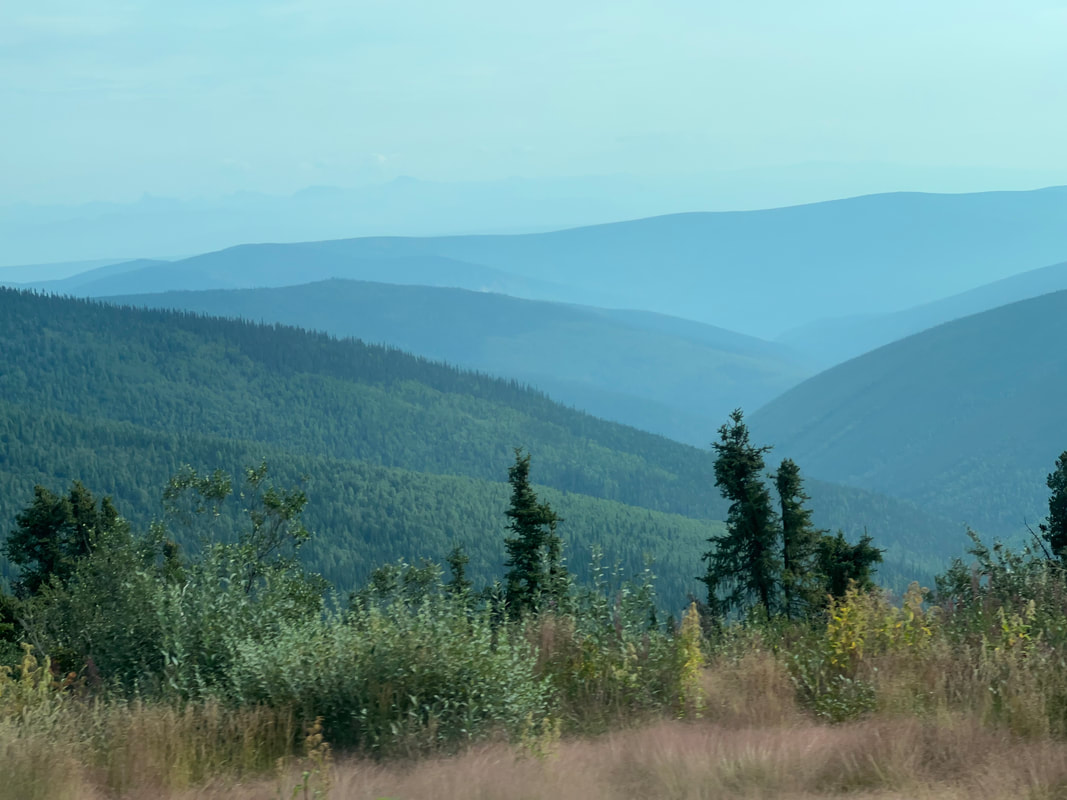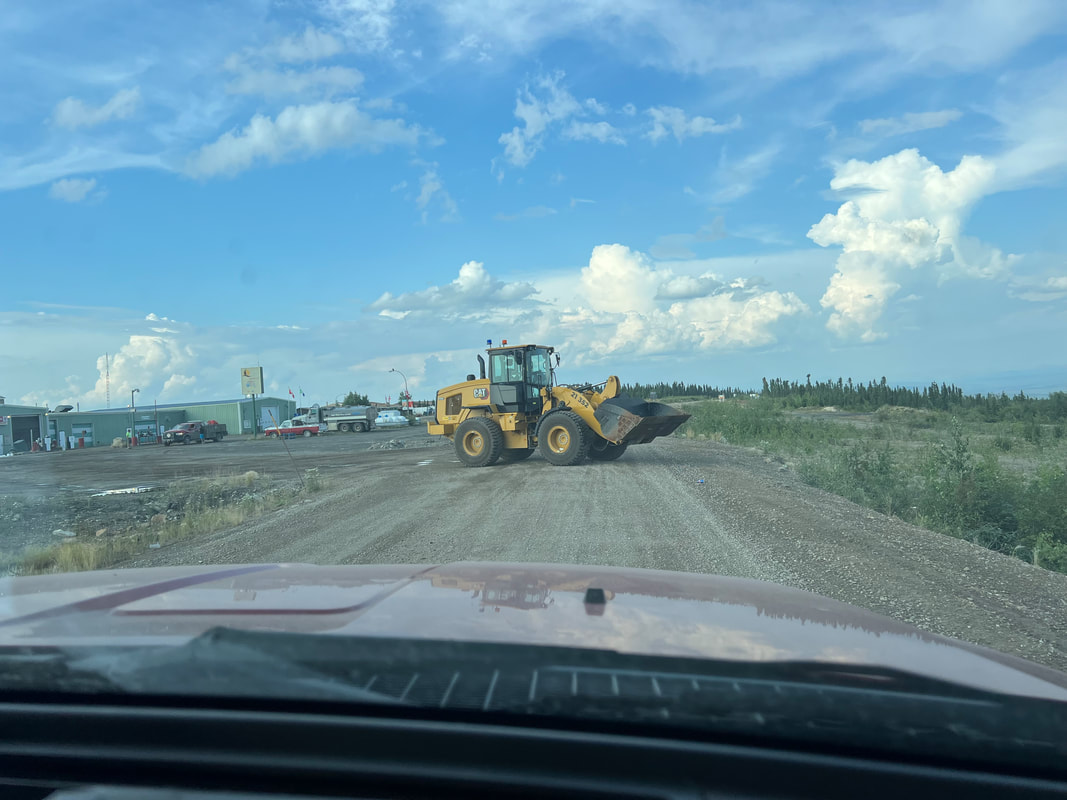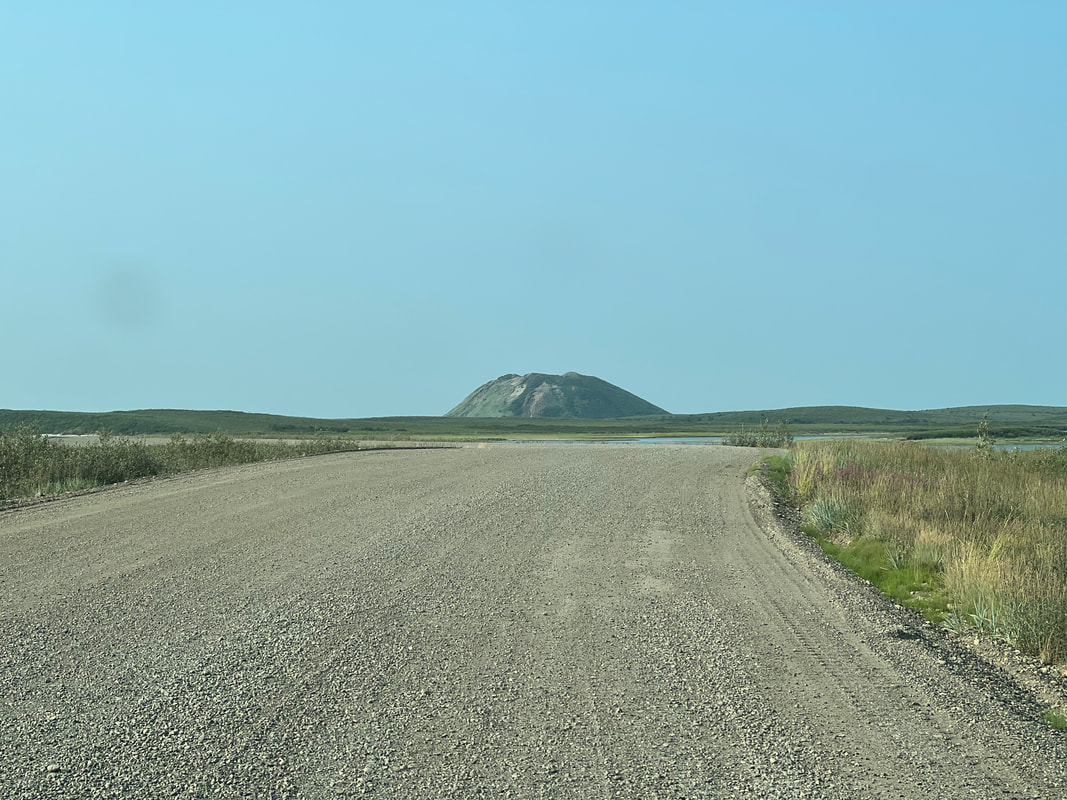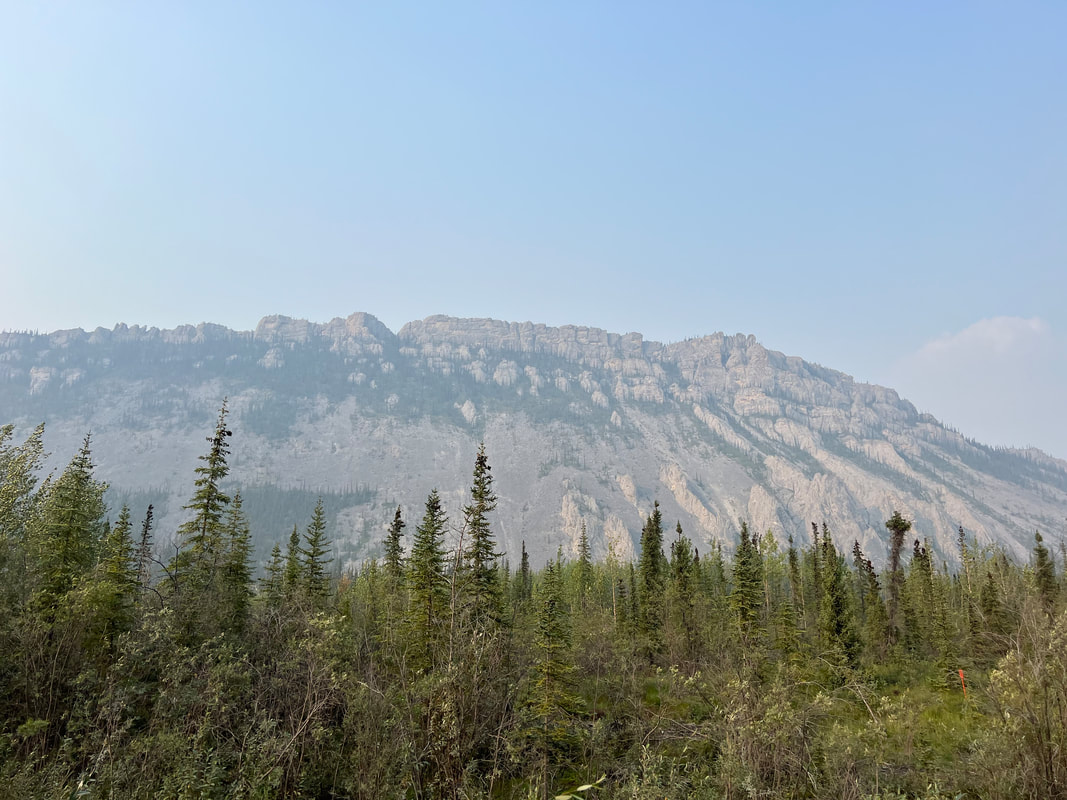|
We left the campground around 9:30, but didn’t get out of Dawson City until almost 11 because of a clog in our kitchen sink drain and then we were looking for a place to get a leaky valve stem fixed, and Tom ended up doing it himself. We took the ferry across the Yukon River to the Top of the World Highway, and thoroughly enjoyed the views, and the very nice dirt road. We had made sure to use all of our produce and potentially objectionable meat before entering Alaska, but the officer at the border only asked us if we had firearms or firewood, and when we said no to both, he said “safe travels” and waved us through and into Alaska. We stopped at the first view which had way too many people, so we went a mile or so down the road to another pull off for lunch, and had a nice short hike up the hill to get an even better view than we’d had at the first pull off. We were a little distressed that our first view in Alaska was of yet another wildfire. We stopped at the Mosqito Fork Dredge trailhead and hiked the .75 miles to the view of the abandoned dredge, and then back to the truck. We then stopped in Chicken, where we saw the Chicken Chicken Statue, and more abandoned gold mining equipment at the Pedro Dredge National Historic Site. Just a few miles down the road we found a family whose trailer springs had broken, and they were trying to fit all of their vacation gear into a small car while waiting for the flatbed to come get their trailer. We couldn’t do much to help, and the father was obsessed with cramming four people and all their stuff into a Honda CRV, which was going to be impossible, but he needed to focus on something other than the difficulty of getting the trailer to somewhere where it could be fixed. The mother ended up giving us some chicken and frozen vegetables because she was fretting about spoiled food, which I could totally understand, so I took the food, thanked her profusely, and we got out of the way. We decided to stop at the Westfork BLM campground since we weren’t sure what the boondocking rules were in Alaska, although when we got there and read the sign we realized we could have pulled off just about anywhere that wasn’t marked for no overnight parking. But, for the $6 the campsite cost, we got to read the official rules, and see two moose crossing the road shortly before the campground. With sunset at 10:23pm and sunrise at 4:44am due to the hour we gained when we entered Alaska, we slept almost normally. We hadn’t realized Alaska is on AKDT, which is one hour behind the Pacific Time Zone, but we were glad.
1 Comment
We finished the laundry at midnight when it was still quite light since the sun didn’t set until 11:40. We filled our water tanks and emptied our gray tank and were out of the campground around 10am. We drove a couple of miles into Dawson City, where we walked around and looked at stuff for a few hours. We ate lunch in the camper in the visitor center parking lot and were on the road about 2pm and onto the Dempster Highway. We decided to stop at the Tombstone Mountain Territorial Campground a little before 4pm even though it’s only about 45 miles north on the Dempster Highway, which was a good thing since by the time we walked over to the visitor center and back less than an hour later, almost every site was full. We got up early, ate, and took two hikes before we left the campground area. The first was a trail from the campground along the river, where we walked to a place on the river where there was still a snowfield in the end of July. Then we drove a couple of kilometers north and hiked up a mountain to amazing views of the mountains, and the valley which gave us a good view of Tombstone Mountain, for which the park was named. We then drove north, in awe of the varied terrain, which changed every 30 or 40 miles but which was always beautiful and awe inspiring. About 30 miles from Eagle Plains, we saw a gigantic forest fire. It wasn’t right on the road, but it was close enough to see some flames and lots of billowing black and gray smoke. We were glad to have it in our rear view mirror. However, when we pulled up in Eagle Plains, where we planned to fuel up and stay for the night, a big front end loader was blocking both the road north, and the driveway into the tourist center, and we could see a sign near the other driveway saying “Road Closed South of Eagle.” A couple of campers pulled up right behind us, and none of us wanted to try to squeeze around the front end loader, so Tom and some of the other travelers went into the gas station to see what was happening. Turns out we were the last few vehicles allowed past the fire, and they weren’t allowing anyone to go south, from the direction we’d come. After about a half hour, someone came out to move the front end loader to let us into the parking lot, and then moved it back to block the road to south going vehicles. We filled up, then went to the hotel/RV park office (and I use the term RV park very loosely), and found that the upside to the inconvenience is that because the fire department had them close the campground for fear trees in it might catch fire, and because nobody could go south and had to stop for the night, they’d made dry camping in their parking lot free no matter which direction you were heading. Since the fire was so far away, we figured the chances of anything catching fire in the area were pretty slim, so we parked in a line of campers in front of the hotel, glad we were going north instead of south in the morning. We slept okay, although with sunset not until midnight, and sunrise at 4:26, it never really got dark and we still weren’t used to sleeping in the daylight. The road south opened around 9am, so we left the campground heading north ahead of anyone who had been held up at the other side of the fire. We reached the Arctic Circle before noon, and then headed for the Northwest Territories/Yukon line, where the road got better and we lost an hour due to the time change. We stopped for lunch at a random pull off and had a nice hike back to a quarry and a lake. We reached the first of two ferries before Fort McPherson, stopped for fuel in Fort McPherson, and then crossed rivers again at the second ferry, which was about an hour from the Vadzaih Van Tschik campground. We had another day of constantly changing scenery, and when we talked about it realized we had both been thinking the same thing - this area felt like home because it reminded us so much of Belize, which is really odd since we were in the Arctic Circle, not the tropics. It helped that it was very warm, with days in the 80s and nights in the low 70s, which the locals said was very strange. But it wasn’t just the temperatures, it was the road and the vegetation and terrain along the road, and how it felt talking to the locals. With the time change, sunset was 1:16am, and sunrise was 4:45am. I discovered a bug with the Apple Watch sunrise/sunset complication; if sunset is after midnight, the sunset time never displays, and it always displays the sunrise time. However, you can get the sunset time by tapping the complication for the full watch screen display. I eventually reported the bug to Apple, but I’ll have to find someone with an Apple Watch who uses that complication who goes to where sunset is after midnight next summer to see if they fixed it. We drove from the campground to Inuvik in about an hour. Inuvik is the end of the Dempster Highway, and used to be the end of the road until about six years ago when the government put the 100 miles of road between Inuvik and Tuktoyaktuk. Inuvik is a pretty big town with just about everything you could want, and after a few days of no cell reception, it had excellent cell reception with good internet. We made a quick stop at the visitor center and then started up to road to Tuktoyaktuk. It took 3.5 hours to cover 95 miles with the southern part being pretty good, but the last 60 miles were washboard. But, the scenery was beautiful again, and with little to no traffic it was pleasant. We camped right on the ocean, where the town is deservedly making good money charging tourists $60CA a night to park. We tried to find a restaurant with local food, but none of the restaurants were open, presumably because everyone was at the Saturday night community baseball game, so we ate in the camper. We stuck our hands in the Arctic Ocean, and decided to hold off on a swim because it was cold. Even though air temps were in the high 70s, the water felt like it was around 45. It was never dark, with sunset at 1:46 am and sunrise at 4:11am, and sleeping was difficult because the locals were running their quads along the waterfront all night looking out to sea for whales to hunt. I wasn’t sure if I was more bothered by the noise or by the light or by the thought of them all jumping in a boat and going out to kill a whale, and I spent too much time convincing myself that the people have a right to their heritage, even if it involves killing intelligent mammals. In the morning, we waded into the Arctic Ocean up to our knees for a quick selfie before leaving Tuktoyaktuk around noon. The drive back to Inuvik was much faster than the drive north, and we pulled into town a little before 3. We got fuel, then looked for a restaurant with local food, but being Sunday afternoon, everything was closed. We parked at the visitor center and took a walk around town before heading south on the Dempster. We were a little worried about running into fire as we headed south since we went through a few patches of fairly dense smoke, but at the Nitainlaii Territorial Park campground, just before the second Fort McPherson ferry, it was pretty clear. The ferry didn’t run until 9am, so the plan was to take a walk around the area in the morning, then head south and try to make it to the Engineer Creek Campground by the next afternoon. We took a walk to the ferry in the morning, then headed south. The walk was interesting, because one of the guys who works with the ferry system stopped and told us how it all works. He had crazy stories about the two season changes, where in the fall the ferry stops running while they wait for the river to freeze so trucks can just drive over it, and then in the spring they shut down to wait for the ice to break up so they can start running the ferry again. Last spring, a lot of rain came with the ice break which caused a jam which caused massive flooding. This worker had a lifeboat tied to his cabin at all times during this season, and last spring he had to use it in the middle of the night when the river came up and over his cabin. As we walked back up the hill from the ferry to the campground, we could see how how high the river had been in the spring. We crossed the ferry, and had smooth sailing until Eagle Plains, where we were stopped and told to follow a pilot truck to the hotel because of thick smoke, which we had noticed for many miles. They were doing a controlled burn around the hotel and gas station to keep the wildfire that had closed the road Thursday night from getting there. We fueled up and continued south, where the smoke remained heavy and we saw where the fire had jumped the road and was still burning on the other side from where we had seen it on Thursday. We stopped at Engineer Creek CG which is at kilometer 194, and the smoke was better, but still visible. The next day we had only another 120 miles of dirt road. We were sort of bummed not to see the incredible scenery from the other direction because of the smoke, but realized how lucky we were in our timing for our drive north. We left Engineer Creek and made a beeline back to Dawson City, where we immediately washed the camper which was black from the last 50 miles of the Dempster Highway. We did some shopping in town, then came back to the same campground where we stayed the night before we drove north, although we splurged on a full hookup site so we could get all of our laundry done, including the dog or cat pissed on sheets, before we headed to Alaska. We were glad to be off the Dempster after almost a week of long and difficult driving days, but sad that that part of our trip was over. We hadn’t really thought about it, but the Arctic Ocean and Alaska were really the end goals of the trip, and now that one of them was checked off the list we were feeling a little at loose ends. We ended up spending another night at the campground, and even splurged on a second night of full hookups, since we didn’t finish washing things until after 4pm. We did seven loads of laundry, washed all the solar panels, cleaned the turbo air filter, and opened the back and had to do a major dust cleanup back there. Unlimited water and drainage was necessary to get all of that done. Tom also helped our neighbor, Sue, who had driven the Dempster with us, and although we’d seen each other, we hadn’t talked until we were campground neighbors. She had a plumbing problem Tom managed to solve, and while he had the ladder and the bucket out to clean our solar panels, he cleaned hers too. She’s on the same track as we are, so we will undoubtedly see her again, although she was staying at the campground for another night because she’d left a window open in her camper one day on the Dempster, and had a lot more interior cleanup than we did. We actually slept pretty well with sunset back to 11:20pm and sunrise not until 5:25am, so we had a few hours of almost darkness.
We left Jasper with the goal of Dawson City within five days, which would involve close to 300 miles of driving a day. The first day, we drove over 300 miles towards Whitehorse from Jasper and made it just over the border into British Columbia. Swan Lake Provincial Park, a little park on a lake, had some short hiking trails so we took a walk, although we were both coughing and sneezing with itchy eyes and throats from the smoke. We hoped to get another 300 miles towards Whitehorse the next day, with Whitehorse being a total of about 900 more miles. Our biggest concern was having adjust our route and timing due to fires. The next day, we drove another 300+ miles to Beaver Lake Campground just past Ft. Nelson. This was a small free campground just off the Alaska Highway, which we entered in Dawson Creek. We saw signs of fairly recent fire, including signs at the entrance to the campground road advising against through travel due to fire, but although it was very smoky, we didn’t see any fire. We set the next day’s goal as Watson Lake. The next day’s drive was probably our most stunning day of driving so far in our trip with beautiful views and many exciting wildlife sightings, all just along the Alaska Highway, not in a park. The count for wildlife for the day on the Alaska highway between Fort Nelson and Watson Lake was a bunch of bighorn sheep, a couple of bunches of bison, a mama black bear and three cubs, and two Caribou. We also saw a spruce quail at the campground before we left. We parked with a bunch of other overlanders in public parking near the Sign Forest, which we walked through quickly because it was raining, but which could be worth a day of wandering to see who posted signs from places we know. The welcome center people were super helpful and not only discretely told us where we could park, but also gave good advice for the trek to the Arctic. Watson Lake didn’t have much, not even a decent grocery store, but since we were heading for Whitehorse the next day, we knew we would be able to get outfitted for the Dempster Highway there. In the morning, we took a quick walk around Watson Lake and got on the road. We stopped to see waterfalls at Ranchería Falls Recreation Site, which were very pretty. That day’s drive was faster but not as interesting as the day before, but got us into Whitehorse in time to get ourselves outfitted to head north - fuel, propane, water, and food. We spent the night in the Real Canada Superstore parking lot so we could head out early the next morning after a walk along the river. The river walk was great, and we got to see a lot of Whitehorse, which is an interesting city. It has everything you need, plus a lot of culture and history. We got on the road around 11 to head to Dawson City. We made the long drive from Whitehorse to Dawson City, which was over 300 miles. The scenery was beautiful but not as awe inspiring, and we had to drive on a lot of washboard dirt roads through construction zones. We figured it was good practice for the Dempster Hwy! We stopped at an old stage stop ruin for lunch, which we found interesting especially since it was a historical site that also served as a rest area. We pulled into Bonanza RV park before Dawson City so we could get our laundry done before getting on the Dempster Highway the next day, after checking out Dawson.
|
Meet the Moonracers
Tom and Marge are taking Moonracer Farm On The Road Again. Follow our journey to build an expedition vehicle and travel! Archives
January 2024
Categories |














































